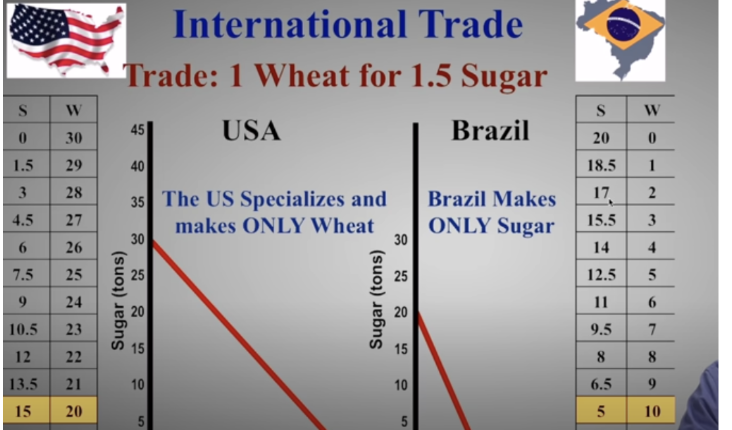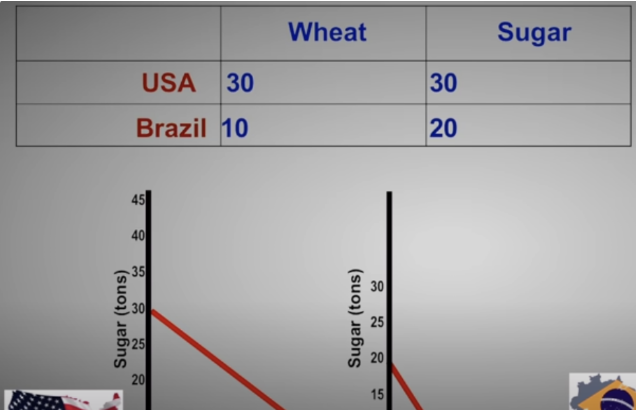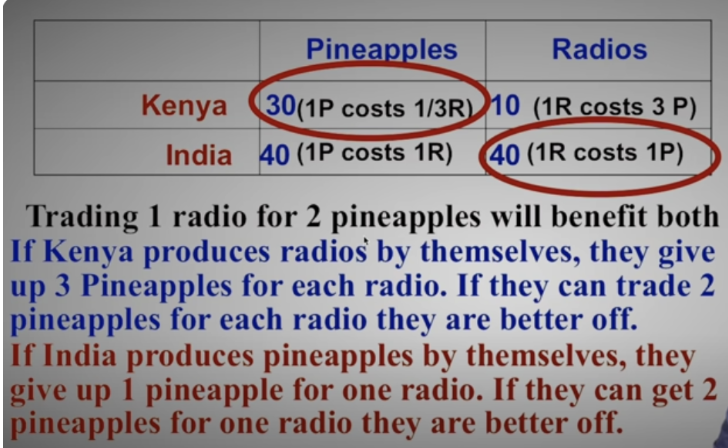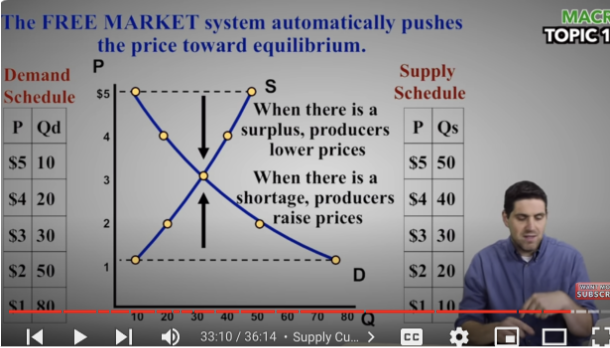AP Macro - Unit 1 Flashcards
1/31
Earn XP
Description and Tags
Name | Mastery | Learn | Test | Matching | Spaced |
|---|
No study sessions yet.
32 Terms
What is economics?
The science of managing scarcity
What is the definition of scarcity?
The idea that we have unlimited wants but limited resources
What is opportunity cost?
The most desirable alternative given up when you make a choice
Ex. Peeta vs Gale: Gale is the opportunity cost
What are the 5 KEY ECONOMIC ASSUMPTIONS?"
Scarcity
Everything is LIMITED, our wants are UNLIMITED
Tradeoff
Everything has a cost BECAUSE of scarcity
Incentives
Humans act in self-interest: incentives are good
Cost-Benefit Analysis
We make decisions based on our perception of if costs outweigh benefits
Math
We can explain stuff with graphs
What’s the actual definition of investment?
IN ECON: investment is when businesses buy stuff to improve their business
What are the 3 types of goods?
CONSUMER GOODS
Created for direct consumption (like pizza)
CAPITAL GOODS
Created for indirect consumption (like ovens)
Capital goods make consumer goods
HUMAN CAPITAL
Knowledge required to produce things (ex. education)
What are the 3 main factors of production?
Land, labor, and capital
What questions determine our economic system?
What goods and services should be produced?
HOW should we produce them?
WHO consumes them?
What are the 3 types of economic systems?
Centrally Planned
Government owns EVERYTHING!!! From marx: communism.
Free Market: Capitalist
Adam Smith: individuals decide whatever: the market does everything!
Mixed Economies
Capitalist (free market), BUT the gov intervenes sometimes
Ex: The US
What is the invisible hand of capitalism?
The Invisible Hand of Capitalism
Society’s goals met while individuals seek their goals (self interest benefits the people)
Business wants to make money? Gotta make awesome stuff!
COmpetition and self interest regulate the free market system.
What is the production possibilities curve: what is the x and y axis?
Def
Logics out the best way to use scarce resources
Demonstrates scarcity, tradeoff, opportunity cost, efficiency
Point Represents…
A specific combination of goods that be produced under a certain allocation of resources (ex. This many bikes and this many computers) given FULL employment of resources
On the x axis goes one resource and on the y axis goes another: represents how much of one thing you can produce while ONLY producing that thing, the other way around, and everything in between.

What do points outside or inside the PPC imply?
Outside: impossible (we dont have enough resources to produce that much)
Inside: inefficient (we aren’t using all our resources)
What is a CONSTANT opportunity cost, and what does it look like on a PPC?
you give up 1 of one thing for 1 of the other thing: result is a linear/straight line PPC>
What is the law of increasing opportunity cost?
Produce more of one good = opportunity cost (lost production of a different good) Increases.
Reason
Resources for production aren’t shared between two products (ex. Pizzas and robots)
Examples
20 pizzas, 0 robots = scientists making pizzas
16 pizzas, 2 robots = perfect balance (everybody is doing what they are good at)
All robots = best pizza makers making robots
Forks/Spoons is a straight line PPC (sme resources to make both)
Forks/Apples is a bowed out PPC (diff resources)
Which is more condusive to economic growth: capital or consumer production?
CAPITAL as it allows you to produce more consumer in the future (its an investment).
What is absolute advantage?
The producer with the capability of producing the most of a product
What’s comparative advantage? Can two trading countries have it?
The country/producer with the lowest opportunity cost when choosing to produce a good
One country can never have both comparative advantages in a product.
Why is trade beneficial? Conjure up a real life example.
EXAMPLE
The US has an absolute advantage in shoes (we’re really big), but a comparative advantage in airplanes (we’re really high tech), and airplanes make boatloads of money
Means we should TRADE if we have lower opportunity cost with other people that make shoes, while we keep specializing in movies
Advantage of Trade
Allows you to produce, even though you aren’t producing yourself: US/Brazil example
Here, US has absolute advantage in wheat AND sugar: but, they choose to specialize in only wheat and brazil specializes in only sugar. By trading at a specific rate, they both experience economic growth.
For example: in this example, US specializes in only wheat and brazil specializes in only sugar bc they have lower opportunity costs respectively: by trading, they both get combos OUTSIDE of their PPC’s, which is economic growth.

How do you find comparative advantage? Give the quick AND the long way of doing it.
First: make a chart
Extremes of production: ex: US makes 30 wheat and 30 sugar, brazil makes 10 wheat and 20 sugar
See who has absolute advantage
EX: see picture
Comparative advantage
Find Opporunity cost
US: 1 wheat costs 1 sugar, 1 sugar costs 1 wheat
Brazil: 1 wheat costs 2 sugars, 1 sugar costs ½ wheat
Thus…
The US should produce wheat: it costs them less sugar to produce 1 wheat
Brazil should produce sugar: costs less wheat per sugar
Find comparative advantage by reducing the numbers down so one of them = 1: for example, mass production of 30 x’s and 20 y’s becomes 3/2 x’s and 1 y. From there, you know 1 y costs 3/2 x’s (obvious) and 1 x costs 2/3 y (just divide it again, this time by 3/2).
QUICK AND DIRTY:
You can never have a comparative advantage in both, so there’s always two scenarios
Just multiply the numbers in each scenario together (ex: 40x20, 50x10)
one scenario means country x produces a’s and country y produces b’s, the other is flipped
that means multiply the absolute advantages of each scenario together.
Whichever scenario produces more units/stuff = that’s the best option
Here: Mexico produces planes, Canada produces cars
In INPUT questions: go for the lower option (remember: protect capital)

What are “terms of trade”
The agreed upon trade to provide econ growth to both countries.
How do you find optimal terms of trade?
First: figure out who’s producing what, and the opportunity costs of each scenario.
From there: analyze ONE column, and pick a number between the two opportunity costs: (ex 1 and 3) and check it with the other column. If it works, yay!

What’s the law of demand, and how can it shift?
Law of Demand
INVERSE relationship between price and QUANTITY deamdn
Ex: price is super high, people won’t buy ito
Price super low, tons want it
Outside Factors SHIFT the law of demand
Ex: milk makes you smarter = more people want it = curve moves right
Milk makes you stupid = less people want it = curve moves left

What are the 5 shifters of demand?
Taste and preferences
Number of consumers
Price of related goods
Income
Future expectations
#F-Pit
What is the law of supply?
DIRECT (positive) relationship between price and quantity supplied
Shift of Supply (shift right or left)
New tech produces milk faster = more quantity of milk. right
Cows die = less quantity of milk. left

What are the shifters of supply?
Prices and availability of inputs
# of sellers
Tech
Government action (taxes/subsidies)
Expectations of Future Profit
#PEG+ (the + is a t, remember like peg + cat)
What is “equilibrium”
Where the demand hits the supply!! YAA

What could cause a shortage or surplus?
Surplus
If price suddenly spikes, we produce more (law of supply), but people dont wanna buy it (law of demand)
= more than we need (surplus)
Shortage
Price low = people wanna buy more = producers dont wanna produce (supply)
Shortage
What is a double shift?
Demand increases AND supply increases = end at equilibrium, but everything is more
*When curves two curves shift at the same time, either th eprice or quantity will be indeterminate
When they both increase: the quantity goes up, price is indeterminate
When they both decrease: quantity falls, price is indeterminate.
What happens when supply goes up?
Prices goes down, quantity goes up
What happens when supply goes down?
Price goes up, quantity goes down.
What happens when demand goes up?
Supply stays the same, price increases, quantity increases
What happens when demand goes down?
Supply stays the same, price and quantity decrease